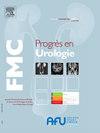Utilisation de l’amikacine comme antibioprophylaxie en urologie : une étude pilote
Q4 Medicine
引用次数: 0
Abstract
Objectif
Nous avons cherché à mesurer la fréquence des infections postopératoires survenues dans une population de patients ayant reçu de l’amikacine comme antibioprophylaxie préopératoire avant une chirurgie urologique.
Méthode
Il s’agit d’une étude descriptive, prospective, monocentrique, incluant des patients ayant bénéficié d’une chirurgie urologique entre octobre 2020 et octobre 2021. Le critère de jugement principal était la survenue d’une infection postopératoire. Les patients ont reçu de l’amikacine en prophylaxie, avec une injection IV la veille et le jour de l’intervention chirurgicale. Une infection postopératoire était définie comme une fièvre ou des signes biologiques d’infection, associés à une sémiologie d’infection urinaire ou à l’identification d’un ou plusieurs germes isolés par hémocultures et/ou ECBU postopératoire, dans les 30 jours suivant l’intervention.
Résultats
La plupart des patients ont subi une chirurgie urologique endoscopique (85,5 %). Chez ces 69 patients, les bactéries les plus fréquemment isolées en préopératoire étaient Klebsiella pneumoniae (36 %) et Escherichia coli (35 %). Le taux d’infections postopératoires était de 5,8 %, sans aucune entérobactérie sécrétant des bêta-lactamases à spectre étendu (BLSE) isolées en postopératoire.
Conclusion
Une faible fréquence d’infection postopératoire a été observée, correspondant dans la littérature aux taux d’infection des patients sans colonisation urinaire préopératoire (ECBU stérile). De plus, aucun patient infecté n’a présenté sur son ECBU postopératoire une bactérie naturellement sensible à l’amikacine, ce qui montre que l’antibioprophylaxie a été efficace sur les bactéries ciblées.
Purpose
We aimed to measure the frequency of postoperative infections that occurred in a population of patients who received amikacin as preoperative antibiotic prophylaxis before urological surgery.
Method
This was a descriptive, prospective, single-centre study, including patients who underwent urological surgery between October 2020 and October 2021. The primary endpoint was the occurrence of a postoperative infection. Patients received amikacin as prophylaxis, with an IV injection the day before and the day of the surgical procedure. A postoperative infection was defined as a fever or biological signs of infection, associated with a urinary tract infection semiology or the identification of one or more germs isolated by blood cultures and/or postoperative urine culture (UC), within 30 days after the procedure.
Results
Most Patients underwent endoscopic urologic surgery (85.5%). Among the 69 patients, urine colonization was mainly due to Klebsiella pneumoniae (36%) and Escherichia coli (35%). The rate of healthcare associated-infection (HCAI) was 5.8%, without any Enterobacteraeae secreting extended-spectrum beta-lactamases (ESBL).
Conclusion
A low frequency of postoperative infection was observed, corresponding in the literature to the infection rate of patients without preoperative bacteriuria (sterile UC). Moreover, no infected patient presented on his postoperative UC a bacterium naturally sensitive to amikacin, which shows that the prophylaxis was effective on the targeted bacteria.
在泌尿科中使用阿米卡星作为抗生素预防:一项试点研究
我们试图测量在泌尿外科手术前接受阿米卡星作为术前抗生素预防的患者群体中发生术后感染的频率。方法是一项描述性的、前瞻性的、单中心的研究,包括2020年10月至2021年10月期间接受过泌尿外科手术的患者。主要判断标准是术后感染。患者在手术前一天和手术当天接受阿米卡星静脉注射作为预防措施。术后感染被定义为术后30天内发热或感染的生物体征,与尿路感染的血液学或通过血液培养和/或术后ECBU分离的一个或多个细菌的识别相关联。大多数患者接受了泌尿内镜手术(85.5%)。在这69例患者中,术前最常见的分离细菌是肺炎克雷伯菌(36%)和大肠杆菌(35%)。术后感染率为5.8%,术后没有分离出广谱β -内酰胺酶(BLSE)的肠道细菌。结论术后感染率较低,文献中与未术前尿路定植(无菌ECBU)患者感染率一致。此外,在术后ECBU中,没有感染患者表现出对阿米卡星自然敏感的细菌,这表明抗生素预防对目标细菌有效。目的:我们的目的是测量在泌尿外科手术前接受阿米卡星作为术前抗生素预防的患者群体中发生术后感染的频率。方法:一项描述性的、前瞻性的、单中心的研究,包括2020年10月至2021年10月期间接受泌尿外科手术的患者。主要终点是术后感染的发生。患者接受阿米卡星作为预防措施,在手术前一天和手术当天静脉注射。术后感染的定义是发热或感染的生物迹象,与尿路感染的符合性有关,或在术后30天内通过血液培养和/或术后尿培养(UC)分离出一种或多种细菌的鉴定。大多数患者进行内镜泌尿外科手术(85.5%)。在69例患者中,尿定植主要是由肺炎克雷伯氏菌(36%)和大肠杆菌(35%)引起的。医疗保健相关感染(HCAI)率为5.8%,没有任何肠杆菌科分泌扩谱β -内酰胺酶(ESBL)。结论:术后感染频率较低,与文献中没有术前细菌(无菌UC)的患者感染率相对应。此外,在术后UC中没有感染患者出现对阿米卡星自然敏感的细菌,这表明预防措施对目标细菌有效。
本文章由计算机程序翻译,如有差异,请以英文原文为准。
求助全文
约1分钟内获得全文
求助全文

 求助内容:
求助内容: 应助结果提醒方式:
应助结果提醒方式:


